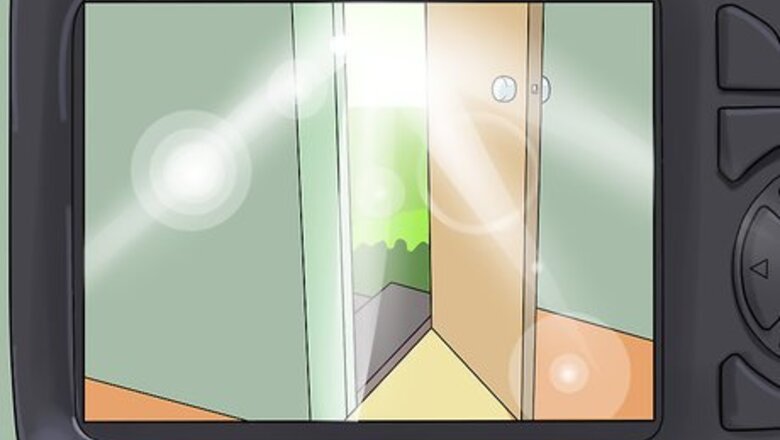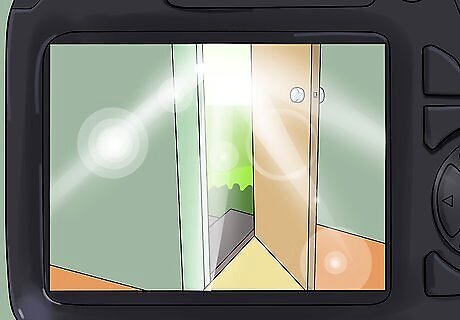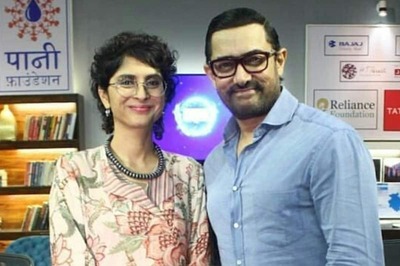
views
Changing the Settings
Create sharp images with a low shutter speed. Shutter speed refers to the amount of time that your lens is actually open. A lower shutter speed will result in a sharper image in terms of visual clarity, but a higher shutter speed will result in more intricate details and color saturation. Importantly, your shutter speed is dependent upon the amount of light that you have access to: the darker it is, the higher your shutter speed will need to be. If your subject is moving, they’ll be blurry if your shutter speed is too long.
Use a lower ISO to keep noise out of your photos. ISO is your camera’s sensitivity to light. A lower ISO will result in a smoother image, but requires a lot of light and a lower shutter speed. A higher ISO will result in a grainier image and requires very little light to achieve an exposure. You almost always want to set your ISO as a low as possible, but in low-light conditions this isn’t simply possible. For a natural-looking image, try to keep your ISO between 50-200.
Set a lower aperture to create a dynamic depth of field. Aperture, also known as f-stop, refers to the size of the lens where light is allowed to enter. A bigger opening means a larger depth of field, so the f-stop determines how blurry elements in the background will be. Oddly enough, the lower the f-stop setting is, the bigger the lens becomes. In other words, f/1 would be a very blurry background while f/22 will make everything in your frame sharp and detailed. Aperture is sometimes referred to as “f-stop” because the number associated with aperture is the focal stopping point. A higher f-stop requires a longer shutter speed, while a lower f-stop requires a shorter shutter speed. For this reason, you’ll only be able to raise your f-stop if there’s a lot of light out. When in doubt, set your camera to f/4. It’s typically the widest aperture setting in natural light that will still separate your subject from the background to make them stand out.
Adjust ISO, shutter speed, and aperture to control exposure. Exposure refers to the way in which aperture, shutter speed, and ISO function together to change how light interacts with a photographic subject. If your photo is too dark, you can try raising the ISO, lowering the aperture, or lowering the shutter speed. If your photo is too bright, you can lower the ISO, raise the aperture, or raise the shutter speed. It all depends on what you want to prioritize in your image: clarity, sharpness, or depth of field. There is no such thing as a good or bad exposure. The trick is to understand when and how you want a certain kind of exposure and adjusting your ISO, aperture, and shutter speed accordingly.
Read your camera’s manual to understand its specific settings. Spending 1 to 2 hours with the manual will help you to understand your specific camera more thoroughly. The sooner you can understand how to change the key components of an exposure, the sooner you’ll be capable of controlling how your photos look. Switching between Basic Modes DSLR cameras have certain modes that are essentially universal at this point. Auto: The camera automatically sets all exposure settings. Program: The camera controls aperture and shutter speed, but you set the ISO. Av: You control the aperture setting, and the camera automatically adjusts shutter speed and ISO. S or Tv: You control the shutter speed and the camera automatically adjusts aperture and ISO
Crafting Smart Compositions
Use negative space as a visual element in your photos. Negative space refers to the elements of a composition where there isn’t an object or subject (like the dark shadows in an alley, or the empty parts of a blue sky). Using a lot of negative space will change the way your viewer interprets the subject of your photo, while avoiding negative space entirely will make your image feel claustrophobic and confrontational. You can always crop your image in editing, so try to start out with more negative space when using your camera. A balance between negative space and subjects or objects results in an even composition, but that’s not always what you want!

Use framing techniques to shift the focus in your photo. Framing refers to the specific location of a camera when a shot was taken. Framing is used to talk about the order of images inside a composition in terms of a focal point, foreground, and background. When you choose to focus on a particular object or subject and ignore others, you’re choosing how you want to frame your photo. When you’ve decided to photograph something, play around with framing by changing where you’re shooting from and modifying the amount of negative space in your image. A focal point is where your eye immediately travels when you look at an image. The foreground refers to the objects in the front of your picture, while the background is a term that refers to all of the objects that are farther away. Look for natural frames, like doorways, windows, and bushes, and use them to play with perspective in an interesting way by shooting around them.
Apply the rule of thirds to create balanced images. The rule of thirds is a common method used for making smart framing decisions. Basically, imagine a 3 by 3 grid of vertical and horizontal lines in your camera. Try to keep important elements and focal points at the intersections between your vertical and horizontal lines. Avoid putting your subject dead-center in your image. This is an extremely traditional framing choice and your photograph won’t appear unique or interesting.
Wait for your subject to relax when shooting portraits. People will naturally change their behavior in front of a camera. They’ll smile, look directly at the lens, and stand unnaturally. None of these behaviors make for interesting photos. If you’re shooting people, wait for them to relax before snapping your image. Just make sure that you always have permission from the person that you’re photographing!TipZoom in close when shooting portraits if you want the person that you’re photographing to be the focus of the image. Not getting close enough is a common mistake when taking photos of people.
Use a tripod and higher f-stop setting for landscape shots. Setting the aperture between f/7 and f13 will result in an image with a balanced sharpness between the foreground and background. Use an aperture in this range when shooting landscapes to ensure that you pick up on a variety of details across the entire range of your shot. A tripod keeps your camera from moving or shaking when the lens is open. This is important when you’re using a higher aperture, since the shutter speed will need to be higher to compensate for the f-stop.
Applying Special Techniques
Try longer exposures when working with a moving subject. Just because something is blurry doesn’t mean that it’s not interesting. Play around with longer exposures to see what happens visually. The play between a still environment and moving subject is often incredibly interesting on a visual level. Set your camera on a tripod when doing long exposures to keep the camera still. This will ensure that the lens picks up rich details in the background.
Set a high shutter speed and turn the flash on to create a double exposure. The flash will ensure that the initial image is captured, while the longer shutter speed will let a second image set into the same photo. The results are often interesting—especially if your subject moves in the time between the initial flash and the remainder of the exposure. Some cameras have a double exposure mode, which allows you to do this without using the flash. Move your camera in between the initial flash and the remaining time on the exposure to generate some truly outrageous and bizarre results.
Change your perspective while shooting to create unique photos. Try standing on top of a table or laying down on the ground when getting a shot. Odd and unique perspectives will result in interesting photos, even if your subject isn’t particularly interesting.
Use flash during the daytime to remove harsh shadows. While flash is typically reserved for shooting in low-light conditions, turning your flash on in the daytime will remove any shadows in the immediate area. This is particularly helpful if you’re trying to get rid of shadows on a person’s face. Flash Popping Up? If you find the flash compartment popping up randomly when you’re shooting, it could be that you have the auto-flash setting turned on. This is a setting in some cameras that automatically turns the flash on if there isn’t enough light to generate a reasonable shutter speed.
Break traditional rules by shooting subjects with multiple settings. One of the advantages of using a digital SLR camera is that you don’t waste any film when you take a bad photo. Experiment with your camera’s settings to see what happens when you change them in counterintuitive ways. Playing with the settings may result in something interesting! Try to intentionally take grainy photos by shooting at a high ISO and low shutter speed to emulate the look of film. Switch your flash off in low-light settings to achieve dreary and dreamy shadows.



















Comments
0 comment